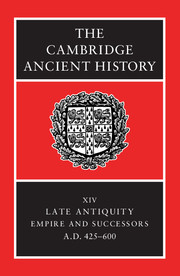Book contents
- Frontmatter
- PART I CHRONOLOGICAL OVERVIEW
- PART II GOVERNMENT AND INSTITUTIONS
- PART III EAST AND WEST: ECONOMY AND SOCIETY
- PART IV THE PROVINCES AND THE NON-ROMAN WORLD
- PART V RELIGION AND CULTURE
- 24 The organization of the church
- 25 Monasticism
- 26 Holy Men
- 27 The definition and enforcement of orthodoxy
- 28 Philosophy and philosophical schools
- 29 Education in the Roman empire
- 30 The visual arts
- 31 Building and architecture
- Conclusion
- Chronological Table
- BIBLIOGRAPHY
- Index
- References
27 - The definition and enforcement of orthodoxy
from PART V - RELIGION AND CULTURE
Published online by Cambridge University Press: 28 March 2008
- Frontmatter
- PART I CHRONOLOGICAL OVERVIEW
- PART II GOVERNMENT AND INSTITUTIONS
- PART III EAST AND WEST: ECONOMY AND SOCIETY
- PART IV THE PROVINCES AND THE NON-ROMAN WORLD
- PART V RELIGION AND CULTURE
- 24 The organization of the church
- 25 Monasticism
- 26 Holy Men
- 27 The definition and enforcement of orthodoxy
- 28 Philosophy and philosophical schools
- 29 Education in the Roman empire
- 30 The visual arts
- 31 Building and architecture
- Conclusion
- Chronological Table
- BIBLIOGRAPHY
- Index
- References
Summary
The definition of orthodoxy between 425 and 600 finds expression primarily in the decrees or statements of the Oecumenical Councils of Ephesus I (431), Chalcedon (451) and Constantinople II (553), which to a large extent were held at imperial instigation. The difficulties of enforcing such definitions, which often had to be upheld by the legislative, military, and even theological and liturgical interventions of emperors, prove that orthodoxy so defined was by no means acceptable to all Christians in the empire. This was particularly the case with the Council of Chalcedon, for its reception and promulgation, or its rejection and condemnation, were played out not only in imperial and patriarchal circles, but also among great numbers of monks and faithful. What, in fact, constituted right belief? Both proponents and opponents of Chalcedon laid claim to orthdoxy, tracing their pedigree in right belief back to the Council of Nicaea (325). An additional complication in assessing the definitions of orthodoxy in this period and the manner in which they were enforced is caused by the development and differentiation in the expression of doctrine. The interpretation of Chalcedon by its sixth-century adherents, for instance, was to differ from the perception of orthodoxy among their fifth-century counterparts. Furthermore, imperial policies adopted for the enforcement of orthodoxy were often dictated by a desire for ecclesiastical unity rather than for the preservation of right belief, which in such cases was used as an administrative tool. Increasingly, different perceptions of orthodoxy, and contrary opinions regarding its enforcement, caused ruptures not only among Christians of the eastern empire, but between east and west as well.
- Type
- Chapter
- Information
- The Cambridge Ancient History , pp. 811 - 834Publisher: Cambridge University PressPrint publication year: 2001
References
- 1
- Cited by

